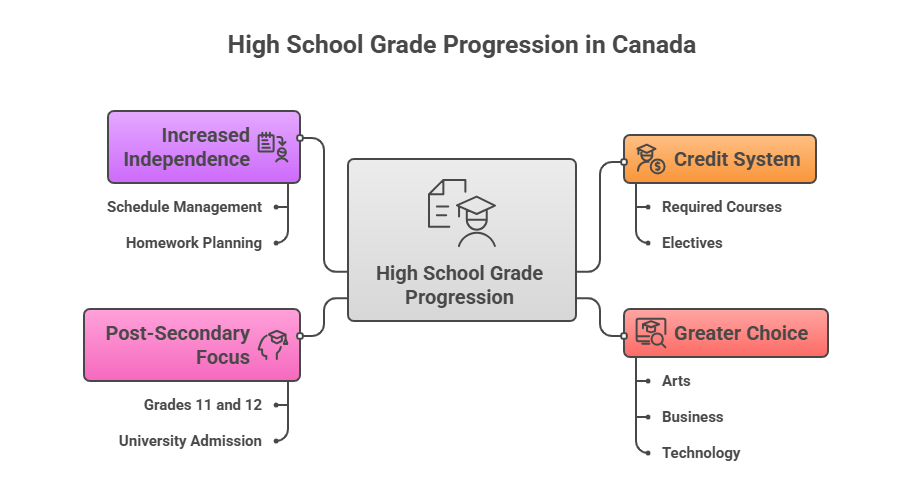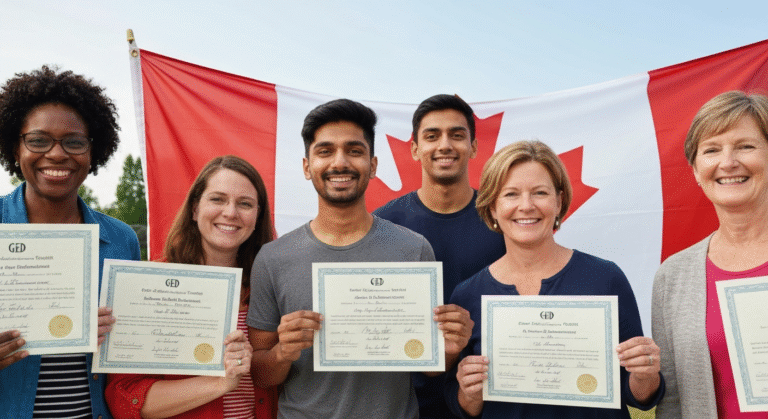Key Highlights of What Grade is High School in Canada?
Here are the key things to know about high school grades in Canada:
- In most places in Canada, high school, also called secondary school, is from grade 9 to grade 12.
- Students usually start secondary school when they are 14. Most finish and graduate at 18.
- The education system in Canada is run by each province, so the rules can be different. Quebec is one place where it stands out.
- When students finish high school, they get a secondary school diploma. This is needed if you want to go to college, university, or other post-secondary programs.
- The Canadian high school grade levels help all students get ready for college, university, or job training.
Introduction
Are you thinking about having your child go to a Canadian high school, or are you planning to move your family? It is important to know how the education system works in Canada, especially if you are wondering what grade is high school in Canada. This helps to make the move easier for everyone. Canadian secondary education is known because it gives students a strong base, and students do really well here.
In this guide, you will get details about high school grades in Canada. It will tell you about how schools are set up, what ages fit each grade, and what changes from one province to another. You will find out what you need to know about secondary school and high school in Canada.
What Grade is High School in Canada?
In Canada, high school usually includes grades 9 to 12. This is the last part of secondary education before you go to university, college, or get a job. If you are from another country, you may hear it called “secondary school.” That is a formal name used by the education boards. Institutions like USCA Academy also align with this standard, providing a structured curriculum for students.
The grade 9 to grade 12 setup is what you see most of the time, but not everywhere. Every province and territory looks after its own education system. Because of that, there can be small differences. Here, we will talk about Canadian high school grade levels and show how they might change depending on the place.
Canadian High School Grade Levels (Grades 9–12)
- Canadian high school usually includes four grades: Grade 9, Grade 10, Grade 11, and Grade 12.
- Students earn credits for passing courses, and a certain number of credits are needed to graduate and receive a diploma, such as the Ontario Secondary School Diploma (OSSD), which is required for college or university applications.
- Grade naming is straightforward, using terms like “Grade 9” rather than “freshman,” making it easy for new students to understand the system. The grade 9 to 12 structure is consistent across provinces like Ontario, British Columbia, and Alberta.
Why High School Starts at Grade 9
The move to high school in Grade 9 marks a key step in a student’s education. Before this, you attend elementary school Kindergarten through Grade 6 or 8 and sometimes middle school or junior high, which covers Grades 7 to 8 or 7 to 9. Grade 9 is when high school usually starts and studies become more focused. You begin thinking about graduation requirements and face harder work. There’s more freedom to choose courses based on your interests, helping guide future career or education plans. Middle school is for basic learning, while high school prepares you for university or college.
Age Ranges for Canadian High School Grades
Understanding the typical age for high school in Canada is important, especially for international families determining the right grade for their children. Generally, students enter Grade 9 at around 14 years old and complete Grade 12 by age 18. This clear connection between age and grade simplifies the process. While school boards assess new students to ensure proper placement, keeping these age ranges in mind can help guide your decisions. Now, let’s explore the specific ages for each high school grade in Canada.
Grade-by-Grade Age Chart
To give you a clearer picture, here is a simple breakdown of the typical age range for each of the Canadian high school grade levels. Keep in mind that a student’s birth date can affect which grade they are in, so some variation is normal.
| Grade Level | Typical Age Range |
|---|---|
| Grade 9 | 14–15 years old |
| Grade 10 | 15–16 years old |
| Grade 11 | 16–17 years old |
| Grade 12 | 17–18 years old |
Unlike the American system, which uses terms like Freshman (Grade 9), Sophomore (Grade 10), Junior (Grade 11), and Senior (Grade 12), the high school system Canada uses is more direct. The numeric terminology is straightforward and avoids confusion, which is especially helpful for international students. The focus is simply on completing each grade to progress toward graduation.
Provincial Variations in High School Grades
- Most provinces in Canada, such as Ontario, British Columbia, and Alberta, follow the Grade 9-12 plan for secondary education; however, each province manages its own school system, leading to variations in the education system across the country.
- Quebec stands out with a different secondary education system, making it essential to understand these differences if you plan to study or live in Canada; we will further explore Quebec’s unique model and other minor variations.
Quebec and Other Exceptions
- In Quebec, high school (école secondaire) starts in Grade 7 and ends in Grade 11, so students typically graduate a year earlier at age 17.
- After Grade 11, Quebec students attend a pre-university college called CEGEP (Collège d’enseignement général et professionnel) for two years before entering university, as universities require completion of CEGEP.
- While Quebec’s secondary education system is unique, some other provinces also have variations, such as starting high school at Grade 10 and placing Grades 7-9 in junior high, though most Canadian schools use the Grade 9-12 high school model.
High School Grade Progression in Canada

In Canadian high schools, you progress through grades by earning credits for completed courses. To graduate, you must obtain both required and elective credits, giving you a clear path each year. As you advance, more options become available, including Advanced Placement and International Baccalaureate programs, which allow you to tackle university-level subjects while still in secondary school. Some of these courses can also contribute to university credits. The first significant transition occurs when you leave middle school and enter high school.
Transition from Middle School to High School
Moving up from middle school to high school in Canada is a big change. Middle school supports you as you adjust from elementary, but high school expects more independence. You’ll have extra freedom and responsibility, which helps prepare you for life after graduation.
At institutions like USCA Academy, these transitions are supported with guidance and resources that help students adapt successfully to high school life.
The main changes you’ll notice are:
- Credit System: High school uses credits, which you earn from required courses and electives you choose.
- Greater Choice: You get to select more classes based on your interests, such as arts, business, or technology.
- Post-Secondary Focus: Courses in grades 11 and 12 are important for university or college admission.
- Increased Independence: You manage your schedule, homework, and planning, building skills for your future.
This system, as seen at USCA Academy and other high schools, teaches you how to take charge and plan your path from grade 9 to 12.
Conclusion
To sum up, it is important to know how the Canadian high school system works, whether you are from Canada or another country. High school in Canada covers grades 9 to 12. Most students in these grades are between 14 and 18 years old. This way of moving from one grade to the next helps students get ready for work or going to a college or university.
The system can be a bit different from place to place, such as in Quebec. The information here helps clear up how the Canadian way of secondary education is not the same as in other places. This can help those who are new to the Canada education system have an easier time. If you want to know more about high school or have other questions about studying in Canada, contact us and we will help you.
Frequently Asked Questions
1. Is Grade 12 the last year of high school in Canada?
Yes, in most Canadian provinces and territories, Grade 12 is the last year of high school. When you finish Grade 12 and meet the graduation requirements, you get a secondary school diploma. For example, in Ontario, this is known as the OSSD. You need a secondary school diploma to apply to university or college. But in Quebec, high school ends with Grade 11.
2. What subjects are mandatory in Canadian high school?
In Canadian high schools, students usually have to take some basic subjects. These are courses like English or French, math, science, and social studies, which may include history or geography. The exact courses you need to get a secondary school diploma, such as the Ontario Secondary School Diploma, can change depending on the province. But these main subjects are a key part of the curriculum in every secondary school in Canada.
3. Are Canadian high school diplomas accepted internationally?
A Canadian secondary school diploma is well-known and accepted by schools all over the world. If you take courses in enriched programs like the International Baccalaureate or Advanced Placement, your application to international universities, including those associated with USCA Academy, gets even stronger. Canada also does very well in worldwide education rankings, as the OECD has said.
4. Can high school students in Canada take college-level courses?
Many Canadian high schools let the students take college courses while still in school. There are two main programs for this. The first is Advanced Placement (AP) and the other is International Baccalaureate (IB). If a student passes these classes and the tests, they can get credits for first-year at a university. This helps give them a good start in their secondary education and college life.
5. Can I join a Canadian high school grade 12 midterm?
Yes, you can join a Canadian high school in grade 12 midterm, but it depends on the school’s policies and your eligibility. Typically, schools require international students to provide transcripts and meet specific criteria. It’s best to contact the desired school directly for guidance on enrollment procedures.









